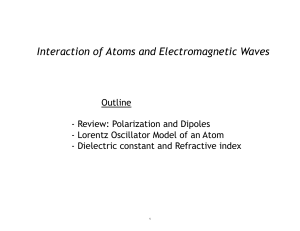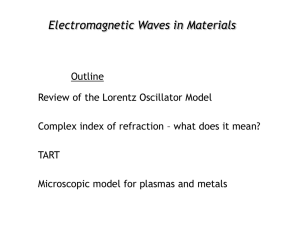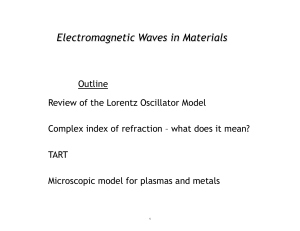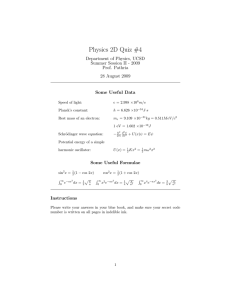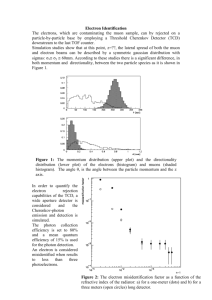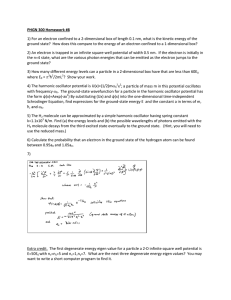Interaction of Atoms and Electromagnetic Waves
advertisement
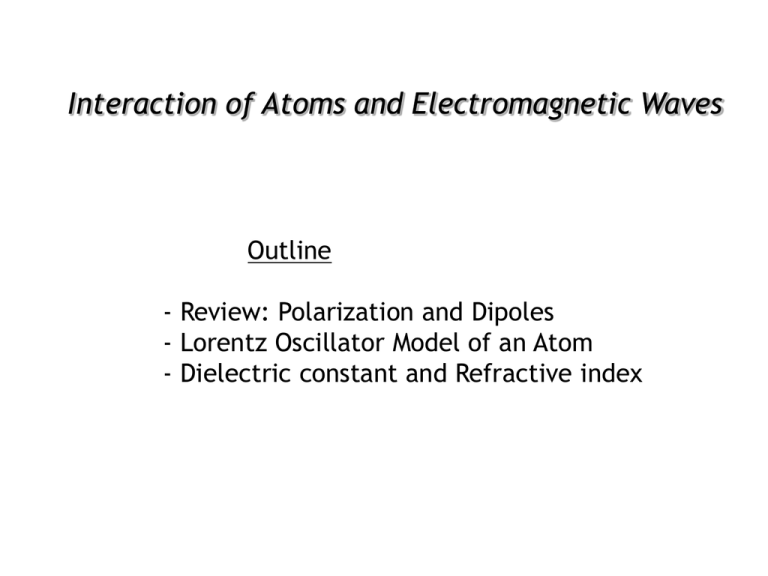
Interaction of Atoms and Electromagnetic Waves Outline - Review: Polarization and Dipoles - Lorentz Oscillator Model of an Atom - Dielectric constant and Refractive index True or False? - + + + - + ++ - 1. The dipole moment of this atom is , and points in the same direction as the polarizing electric field. - 2. The susceptibility relates the electric field to the polarization in this form: 3. The refractive index can be written NI 2πr Refractive Index: Waves in Materials Index of refraction How do we get from molecules/charges and fields to index of refraction ? Index of Refraction Material frequency wavelength When propagating in a material, Vacuum 1 Air 1.000277 Water liquid 1.3330 Water ice 1.31 Diamond 2.419 Silicon 3.96 at 5 x 1014 Hz λ (m) 103 102 101 1 10-1 10-2 10-3 10-4 10-5 10-6 10-7 10-8 10-9 10-10 10-11 10-12 Radio waves IR UV Microwaves “Hard” X-rays “Soft” X-rays Gamma rays Visible Absorption Photograph by Hey Paul on Flickr. Why are these stained glass different colors? Tomorrow: lump refractive index and absorption into a complex refractive index Absorption coefficient Refractive index Incident Solar Radiation How do we introduce propagation through a medium (atmosphere) into Maxwell’s Equations? Image created by Robert A. Rohde / Global Warming Art. Used with permission. Microscopic Description of Dielectric Constant - + + + + + + - + + + + + + - - - NO external small amount of charge moved by field E field Nucleus Electron Density of dipoles… “spring” Electric field polarizes molecules… … equivalent to … Lorentz Oscillator Lorentz was a late nineteenth century physicist, and quantum mechanics had not yet been discovered. However, he did understand the results of classical mechanics and electromagnetic theory. Therefore, he described the problem of atom-field interactions in these terms. Lorentz thought of an atom as a mass ( the nucleus ) connected to another smaller mass ( the electron ) by a spring. The spring would be set into motion by an electric field interacting with the charge of the electron. The field would either repel or attract the electron which would result in either compressing or stretching the spring. Nucleus Electron “spring” Hendrik Lorentz (1853-1928) Nobel in 1902 for Zeeman Effect Lorentz was not positing the existence of a physical spring connecting the electron to an atom; however, he did postulate that the force binding the two could be described by Hooke's Law: where y is the displacement from equilibrium. If Lorentz's system comes into contact with an electric field, then the electron will simply be displaced from equilibrium. The oscillating electric field of the electromagnetic wave will set the electron into harmonic motion. The effect of the magnetic field can be omitted because it is miniscule compared to the electric field. Image in public domain Springs have a resonant frequency Hooke’s Law Solution ω0 So we can write: ω0 Microscopic Description of Dielectric Constant Nucleus Electron “spring” Damping Electron mass Restoring force (binding electron & nucleus) field force Solution using complex variables Lets plug-in the expressions for and into the differential equation from slide 9: Natural resonance + + + + + + Oscillator Resonance Driven harmonic oscillator: Amplitude and Phase depend on frequency Low frequency At resonance High frequency medium amplitude large amplitude vanishing amplitude Displacement, in phase with Displacement, 90º out of phase with Displacement and in antiphase Polarization Since charge displacement, y, is directly related to polarization, P, of our material we can then rewrite the differential equation: For linear polarization in direction Dielectric Constant from the Lorentz Model Microscopic Lorentz Oscillator Model Real and imaginary parts Dielectric constant of water Magnitude 80 60 40 20 1 10 Frequency (GHz) Microwave ovens usually operate at 2.45 GHz Complex Refractive Index Absorption Coefficient Absorption Refractive index [cm-1] Absorption Absorption coefficient Refractive index Beer-Lambert Law or Beer’s Law Key Takeaways Nucleus Lorentz Oscillator Model Electron “spring” Decay Absorption coefficient Beer’s Law Refractive index MIT OpenCourseWare http://ocw.mit.edu 6.007 Electromagnetic Energy: From Motors to Lasers Spring 2011 For information about citing these materials or our Terms of Use, visit: http://ocw.mit.edu/terms.
